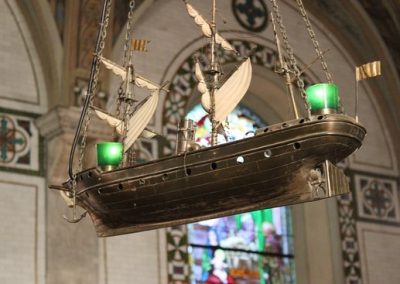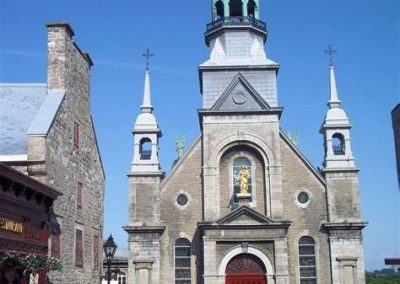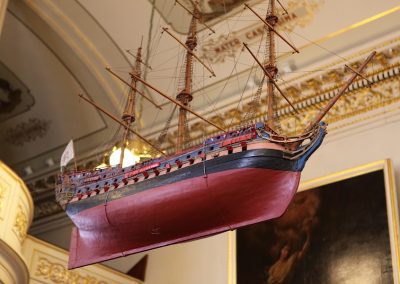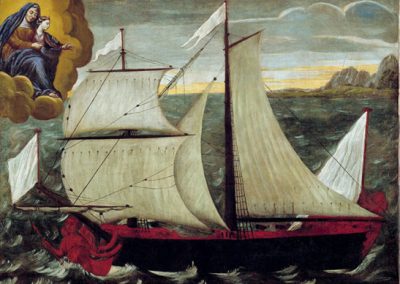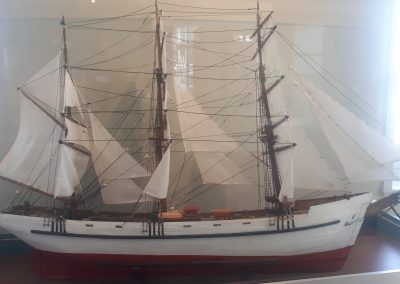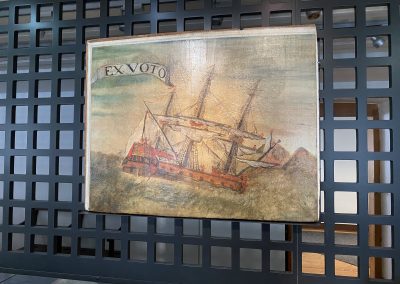The votive boat’s devotion in Canada
Votive ships in New France:
A votive ship is a model of a ship displayed as an ex-voto in a church, that is to say given to the church in thanks for a favor obtained. The practice of displaying model ships in churches originated in the Middle Ages and spread throughout Christian Europe. The oldest known ex-voto is a Spanish model dating from the 15th century.
Votive ships are quite common in the coastal towns of France, in the form of models or paintings. The Basilica of Sainte-Anne d’Auray in Brittany has the largest collection of these in France. From 1608 to 1760, 47,000 Frenchmen set foot in North America; 17,000 settled there and 11,000 started families. In addition, 2300 subjects claimed Breton origins. Since a large portion of the population came from the coastal cities of France, it is not surprising to find some votive ships in the churches of New France.
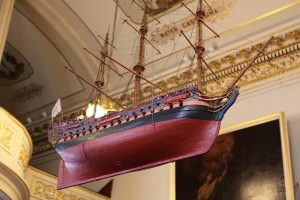 The first votive ship in New France:
The first votive ship in New France:
A picture painted in 1747 was added as an ex-voto dedicated to the Virgin Mary for saving the ship L’Aimable Marthe from sinking. Then, a second ex-voto, in the form of a votive ship, was suspended from the vault of the nave. It is a replica of the Brézé, a ship that carried part of the Carignan-Salières regiment sent to New France in 1665 to counter the Iroquois threat. Originally hung from the ceiling of the Notre-Dame de Québec Cathedral Basilica, it was severely damaged when the vault collapsed in 1759 after a fire. In 1955, after its restoration, it was relocated to the Notre-Dame-des-Victoires church in Quebec City.
The votive ship of the Pontifical Zouaves:
On October 19, the Canadian Zouaves left Liverpool aboard the “Idaho” and headed for New York. Two days after departure, a violent storm unleashed the fury of the ocean waves against the steamer. “The ocean roared, hissed, howled, and roared with greater force and rage, the mountains of water which came crashing sometimes on the bow, sometimes on the stern of the vessel, were more and more heavy and threatening; the frame of the ship seemed to be breaking apart; when suddenly a frightful noise, like that of lightning falling on the bow, was heard; At the same time, a terrible jolt was felt as if the ship had struck a rock, and before realizing the accident, the Zouaves heard immense columns of water rushing into their compartment. An anchor was swept away by a strong wave from the upper deck, leaving behind it a large exit for the waves to flood the tween deck; One sees oneself in front of death, and these waves seem to come to seek corpses; while some cling to the objects which they can meet under the hand, that the others throw themselves to the swim in this small interior sea, a voice dominating all the noise is heard; it is a zouave which orders to his comrades to raise their heart towards Marie and to promise her an ex-voto, if they arrive at good port. It was around midnight.
The next day, the waves, as if tired, only obeyed the movement printed the day before, the wind had fallen, the sky was pure, all the 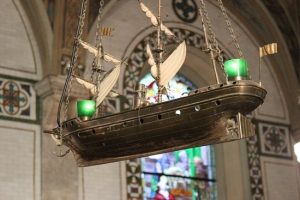 passengers, mounted on the deck, breathed with the fresh air, hope and happiness; the zouaves thanked the Virgin Mary, to whom they attributed their salvation. “
passengers, mounted on the deck, breathed with the fresh air, hope and happiness; the zouaves thanked the Virgin Mary, to whom they attributed their salvation. “
On November 6, the Canadian Pontifical Zouaves made a truly triumphal entry into the city of Montreal amidst the cheers of fifty thousand people who had flocked to the station to welcome them… Before parting and flying into the arms of their parents, the soldiers of Pius IX, accompanied by the bishop, went to the chapel of Bonsecours to fulfill their vow to the Virgin Mary. A small silver ship, a facsimile of the “Idaho”, now hangs from the vault of this church; it is the ex-voto promised by the Canadian Zouaves.
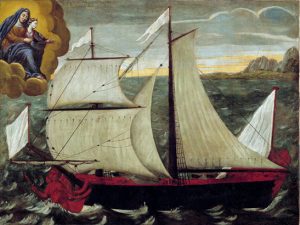 Votive ships in the form of canvas:
Votive ships in the form of canvas:
Sometimes, it will be by paintings that Canadians will illustrate their acts of gratitude for the protection of Heaven. There is a famous ship called the Joybert which is represented on an ex-voto of 1706. The Quebec City shipowner Louis Prat commissioned this painting to thank Saint Anne for the capture of the Pembroke Galley by the Joybert, commanded by Jean Léger de La Grange. This painting is now in the museum of the Basilica of Sainte-Anne-de-Beaupré.
Sources:
-C.-E. Rouleau, La Papauté et les zouaves pontificaux.
Frère Ernest-Béatrix, Histoires canadiennes, La Vierge Marie, deuxième édition, pages 58 à 60.

